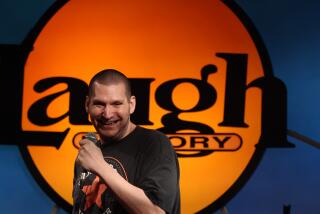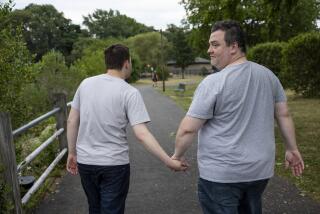Learning to Read a Smile
In a Sherman Oaks schoolroom, 17-year-old Tom Iland is sitting through one of his toughest classes.
It’s not science: Tom is good at science. Not math: When he was in ninth grade, he tested as equivalent to a college senior in math. The class is “social skills,” and Tom is poring over the importance of smiling and frowning at the proper time and place.
“When you use appropriate facial expressions,” he reads, “you may avoid getting into trouble. You may make a good impression. You show you respect others.”
Then the teacher expands.
“You can tell a lot about what a person’s feeling by the way they look. When I’m smiling, for instance, my mouth is like this and my eyes are more creased up,” she says.
Tom Iland has to learn these so-very-basic things by rote--about how to have a conversation, how to make a friend, how to look someone firmly in the eye, how to read expressions on a face or interpret the tone of a voice.
In some ways, he’s so smart. Socially, he’s at sea.
In the past, no one knew what to make of people like Tom--writing them off as “nerds” and “geeks,” oddballs and eccentrics or diagnosing them as behaviorally disturbed.
Tom’s condition is a neurological disorder called Asperger’s syndrome. Debates continue about its precise nature and prevalence, but it is known to run in families and to affect more boys than girls. It is often accompanied by obsessive interests in quirky topics such as roller coasters or industrial cooling towers--and sparks of brilliance in areas like music or math.
No one is sure how many people have Asperger’s. Some estimate that as many as one in 250 people has at least a mild case.
Specialists classify it as a variant of autism--subtler, but often crippling.
People like Tom aren’t sitting in corners, mute, aloof and indifferent to others, like the textbook autistic child. Quite the opposite. Many are only too aware of their differentness and are confused and unhappy when their attempts to find friends and get by in the world fail time after time.
Because of their precocious talents and strangely grown-up speech, they’re sometimes termed “little professors.” But, just as with autism, something is amiss with the social parts of their brains, creating an impaired ability to sense or imagine others’ feelings or to pick up on the elaborate, unwritten rules of social discourse.
And that is a giant handicap.
* Try making a friend if you don’t even know to say “hi” when you meet and “ ‘bye” when you leave, when you can’t imagine how another person feels.
* Try getting a job if you don’t know how to smile, chat brightly about career goals and look your future boss in the eye.
* Try finding success in love if you have no clue whether a kiss will be welcome.
* Try getting along with anyone if you don’t know when it’s time to tell a lie.
Today, children with Asperger’s syndrome--named for the doctor who first described the condition, in the 1940s--are getting diagnoses and help. At the same time, men and women of an older generation are getting diagnoses, too: ones that for some shed light on decades of social awkwardness, depression and underachievement.
The challenge for Asperger’s specialists is figuring out how to teach things they never had to consciously learn.
“Nobody taught you how to have a friend. Nobody taught you how to read a face. Nobody taught you empathy or social reasoning,” says Tony Attwood, a clinical psychologist in Queensland, Australia, and an expert on Asperger’s.
Most Signals Don’t Involve Words
Most of the signals we send each other don’t come from words. They’re transmitted by the pucker of a lip, the shrug of a shoulder, the hard or soft edge to a voice. Our brains are designed to pick up on the nuances.
Imagine if all those signals came to you in Cantonese--and you spoke only English. That’s what having Asperger’s is like, says Jerry Newport, 52, a Los Angeles resident who was diagnosed in 1995.
“There’s always been lots of things that I’ve felt other people naturally did that I couldn’t do without rehearsing,” Newport says. “People know when to talk and when not to talk and how long to talk. They know how to read the nods and smiles, to know when someone’s really listening to you or just enduring you.”
Newport has worked hard to learn this foreign tongue, memorizing many “scripts” for how to act in different social situations. Yet it always takes effort, he says. He’ll never be a native speaker of this strange social language.
The toll on his life has been huge. A college grad with a talent for math, he could mentally multiply four-digit numbers and figure out square roots of 8-digit numbers by age 7. But he would flub job interview after job interview. At one, when asked about his plans for the future, he answered, “I guess if the interview’s over I’ll go down to McDonald’s and then catch some races at the track.” He spent years driving cabs and trucks and getting fired from many of those jobs.
And he just didn’t get the subtle language of love. Told that he didn’t look into women’s eyes enough, he would overcompensate and stare them down in bars for 20 minutes at a time. Told that women liked men who could dance, he would focus all his efforts on fancy disco steps.
“I was thinking, ‘Oh man, how can they not fall in love with this guy who knows exactly how to dance to every song?’ Very often, halfway through the song, I’d turn around--and my partner would be gone. I couldn’t understand why it was happening.”
Today, Newport gives talks about Asperger’s--and has formed an L.A. group where adults like him can meet and glean support. He was briefly married, to a woman who also has Asperger’s. He and his ex-wife recently agreed to try to reconcile.
He hopes life will be easier for people like Tom Iland.
Interests Are Very Focused
As he sits in an armchair in his Santa Clarita Valley home, Tom Iland’s discourse is measured and formal. Often, his eyes avoid yours. His speech lacks many of the ups and downs that most people have, but gets more animated when he talks about “Star Wars,” roller coasters or “Who Wants to Be a Millionaire?”--his great loves.
“Personally, I think everyone’s their own unique person,” he says quietly. “Asperger’s is kind of a gift in a way. It makes me like what I like.”
Tom’s special interests are more mainstream than those of some with Asperger’s, who enthusiastically amass facts on fishing tackle, deep fat fryers or the passenger list of the Titanic. Yet his passions are just as intense: If allowed to, they would consume his life.
When Tom draws, he draws only “Star Wars” and “Millionaire” logos. “Star Wars” trivia and roller coaster books are the only ones in view in his room. Tom’s parents have had to lay down rules to limit his habit of repeatedly quoting lines from movies or the credo of the Jedi Knights or of imitating Yoda from “Star Wars” (“In trouble you are!”)--which rile his brother and sister.
Oddness of this type wasn’t what Tom’s parents noticed first, though.
At age 2, Tom Iland started spontaneously composing words with refrigerator magnet letters.
On his first day of preschool, he read a book to his class; in kindergarten, he effortlessly mastered the multiplication tables.
“We didn’t think we had a child with a problem--we thought we had a genius,” says Emily Iland, Tom’s mother.
Yet in other ways, Tom seemed backward. At preschool, he wouldn’t join in circle time. Play dates and imaginary games were not for him: He preferred rewinding videos over and over so he could watch his favorite parts--all day, if his mom would have let him.
By seventh grade, when the condition was diagnosed, the gulf between Tom and his peers had grown huge. Kids didn’t get Tom Iland. He didn’t look at them. When he talked, he would talk on and on about roller coasters--and when he was done, he would just walk away.
When kids on his baseball team didn’t hit the ball well, Tom told them just what he thought of them--and at the end-of-season pool party, they dunked him so thoroughly that his mom thought they would drown him.
Every day, he would approach his peers on the playground; every day they would tease him and send him packing.
“They sensed his differentness and were rejecting him,” says Emily Iland. “It was blatant to everybody else, but he didn’t get it.”
A Literal Sense of Language
Asperger’s syndrome makes it all too clear that, without social smarts and common sense, you can have an IQ the size of a planet and still be forever floundering.
People with Asperger’s take language very literally: “A mom might say to a bright teenage Asperger lad, ‘Go put these toilet rolls in the toilet’--so what do you think he does?” says Dr. Lorna Wing, a British psychiatrist who brought international attention to the syndrome in the 1980s.
And Asperger’s children say just what they think, such as, “You’re fat!” or “That’s stupid!”--even if the fat or stupid person is a teacher or a boss.
People with Asperger’s believe strongly in rules and routines, often designating themselves the “rule police.” This doesn’t endear them to their peers. In the Iland home, such “parent-policeman-judge” behavior (such as Tom’s ordering his brother and sister to comply with rules about bedtimes) is banned.
The inability to read a face, meanwhile, can be so profound that even a basic thing like a smile can confuse an Asperger’s child. Such a child might pucker his face and ask: “So-and-so went like this. Should I go like this too? Should I cry? What should I do?”
And often, layered on top of these social holes are other conditions that, for reasons unknown, afflict Asperger’s kids: obsessive-compulsive disorder, anxiety, depression, suicidal thoughts and acts.
Sometimes the children are cut to the quick by the realization that they’re different. Others, like Tom, protected by their own lack of insight, don’t fully see the shunning by their peers.
By ninth grade at Saugus High School, Tom Iland’s blindness to social codes was leading him into deeper water. One day, a schoolmate let off a smoke bomb and the teachers offered a reward to anyone who would inform on the prankster. Tom didn’t hesitate. In full view of his classmates--with no clue you’re supposed to be sneaky when you snitch--he rushed to the office and told all he knew. A crowd of kids was waiting for him later, but Tom, on this occasion, was spared the wrath of his peers: He hadn’t reported the boy because he couldn’t recall his name.
Tom wasn’t so lucky another time, when a physical altercation left him with a sprained wrist, a bruised head and a cut back. At that point, his parents and school officials agreed that Tom would do better in a more sheltered place. He moved to Village Glen, a school in Sherman Oaks that specializes in teaching children with Asperger’s syndrome--a place where social skills are as much a part of the curriculum as math or English.
At Village Glen, pupils get “empathy tests.” They put together “body gesture scrapbooks.” They learn the art of telling little white lies (aided by a special lying textbook) so Grandma will never know what they really thought of her braised carrots.
Parents and educators half-joke that children who go through social skills programs like this end up more polite than their brothers and sisters. Yet there’s nothing easy about learning or teaching this stuff.
Educators and psychologists are still struggling to distill our convoluted social rules down to bite-sized principles that students can learn.
Creativity is the order of the day.
Soap operas--with the raunchy scenes edited out--are handy for teaching body language and facial expression. “They are overacted beyond belief,” says Laurie Stephens, co-director of the Village Glen program.
Piling up blocks--one for each appropriate contribution to a conversation--encourages students to keep the discourse flowing so they can enjoy watching the tower grow higher and higher. There are tailor-made stories to teach rules for getting along with people. And charts to teach the meaning of frowning or smiling faces.
After two years at Village Glen, Tom is proud of his progress. He has learned to look people in the eye, rein in those “Star Wars” and roller coaster monologues and not interrupt. He has learned about different tones of voice--as well as rules for talking on the phone and starting and joining conversations.
“For starting a conversation, first introduce yourself: ‘Hi, I’m Tom,’ ” he demonstrates, smiling. “Shake hands. ‘Are you taking this class? Do you like it?’ Ask questions--that’s one way to find things out.
“With joining in, first you kind of wait for the appropriate time. A pause. They talk, they talk, they talk, and then you say your thing. They’re talking about the ‘Millionaire’ last night; you say, ‘Yeah, that was cool.’ ”
Emily Iland says Tom has learned so much. Just recently, she says, there he was, actually talking on the phone with a friend--a friend.
“That was one of my happiest days as a mother,” she says. “It’s something that seems so kid-like, and yet here he was, 16 1/2 years old and it was the first time it happened for him.”
There are still big gaps, she says--especially in Tom’s ability to imagine how other people feel, one of the hardest things to teach to those with Asperger’s.
But Emily Iland knows Tom wants to return to Saugus High, and will soon be going to a local community college--he wants to be a banker or a roller coaster designer. He’ll have to leave his sheltered world.
In the meantime, she’s doing what she can to make the outside world safer for him. With other parents of Asperger’s children, she has talked to security guards at the mall and to local policemen--hoping that if they see a person committing a stupid crime, they’ll consider the possibility he has Asperger’s. A card describing Tom’s condition is in his wallet so he can take it out and show it if he gets into trouble.
And she has talked at schools about people like Tom, hopeful that people will be less inclined to shun when they understand.
Perhaps her biggest success is working with her local school district to implement a mentoring program at Saugus High and other schools. Under the plan, students will get credit for “buddying” Tom and other children who need social help.
“It will work out at Saugus,” Tom says. “Some people will think there’s nothing wrong with me and think this is a bunch of bull.
“Others will say: ‘I never knew this. Want to go to the game with me?’ ”
(BEGIN TEXT OF INFOBOX / INFOGRAPHIC)
Support and Information on Asperger’s
* General Information: Autism Society of Los Angeles, 1612 W. Olive Ave., Suite 201, Burbank, CA 91506; (818) 953-3855; https://www.autismsocietyla.org.
* Support Groups: Adults Gathering, United and Autistic (AGUA), (818) 953-3855; Asperger’s Parent Support Group, Fran Goldfarb or Jim Devine at (310) 202-6546, or https://clawww.lmu.edu/Faculty/JDevine/AS/LAAPSG.html.
* Programs and services: The H.E.L.P. Group, (877) 943-5747, https://www.thehelpgroup.org; UCLA Family Support Community Program, (310) 206-6150.
* Other Web sites, including writings from those who have the condition: https://www.aspennj.org, https://www.udel.edu/bkirby/asperger, https://aspie.com, https://www.asperger.org.
*
More Inside
Autism: Advances in treatment give hope. But crucial early intervention remains difficult, S1






